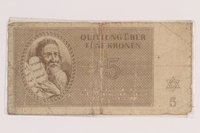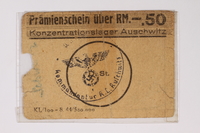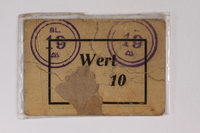Overview
- Interviewee
- Chaim Hollander
- Interviewer
- Allen Hollander
- Date
-
interview:
1984 October
- Credit Line
- United States Holocaust Memorial Museum Collection, Gift of Lydia Hollander
Physical Details
- Language
- English
- Extent
-
1 sound cassette (90 min.).
Rights & Restrictions
- Conditions on Access
- There are no known restrictions on access to this material.
- Conditions on Use
- No restrictions on use
Administrative Notes
- Legal Status
- Permanent Collection
- Provenance
- Lydia Hollander donated her parents' collection to the United States Holocaust Memorial Museum in 2010. The oral history interview with Chaim Hollander was transferred to the Archives in June 2010.
- Funding Note
- The cataloging of this oral history interview has been supported by a grant from the Conference on Jewish Material Claims Against Germany.
- Special Collection
-
The Jeff and Toby Herr Oral History Archive
- Record last modified:
- 2023-11-16 09:18:56
- This page:
- https://collections.ushmm.org/search/catalog/irn40074
Download & Licensing
- Request Copy
- See Rights and Restrictions
- Terms of Use
- This record is digitized but cannot be downloaded online.
In-Person Research
- Available for Research
- Plan a Research Visit
Contact Us
Also in Chaim and Regina Hollander collection
The collection consists of artifacts, documents, an oral history audiocassette, and photographs relating to the experiences of Chaim Hollander in Poland during and after the Holocaust, and of Kajla-Rykwa Miller in Belgium during the Holocaust.
Date: 1940 March 02-1947

Theresienstadt ghetto-labor camp scrip, 5 kronen note
Object
Scrip, valued at 5 kronen, issued in the Theresienstadt (Terezin) ghetto-labor camp in 1943 and owned by Chaim Hollander. All currency was confiscated from deportees upon entry and replaced with scrip and coupons that could be exchanged only in the camp. After Germany invaded Poland in September 1939, Chaim and his family went into hiding. In August 1942, they were deported from Sosnowiec to the Srodula ghetto. After his wife and two young daughters were deported, Chaim escaped the ghetto and lived under a false identity until he was betrayed and deported to Auschwitz-Birkenau in December 1943. He found Fajwal there and they were transferred together to Sachsenhausen. Later they were deported to Mauthausen and then Ebensee, where they were liberated by the US Army on May 6, 1945. Chaim relocated to Belgium, where he had relatives. He heard from a neighbor that his wife was seen in Auschwitz, but was killed there.

Auschwitz concentration camp scrip type 3, .50 Reichsmark, received by a Polish Jewish inmate
Object
Type 3 Auschwitz scrip, valued at .50 Reichsmark, received by Chaim Hollander when he was imprisoned in Auschwitz-Birkenau. Scrip was issued in the camps as a means of improving worker productivity. After Germany invaded Poland in September 1939, Chaim and his family went into hiding. In August 1942, they were deported from Sosnowiec to the Srodula ghetto. After his wife and two young daughters were deported, Chaim escaped the ghetto and lived under a false identity until he was betrayed and deported to Auschwitz-Birkenau in December 1943. He found Fajwal there and they were transferred together to Sachsenhausen. Later they were deported to Mauthausen and then Ebensee, where they were liberated by the US Army on May 6, 1945. Chaim relocated to Belgium, where he had relatives. He heard from a neighbor that his wife was seen in Auschwitz, but was killed there.

Sachsenhausen-Oranienburg concentration camp scrip, wert 10, received by a Polish Jewish inmate
Object
Scrip received by Chaim Hollander when he was imprisoned in Sachsenhausen concentration camp. Scrip was issued in the camps as a means of improving worker productivity. Chaim and his brother, Fajwal, worked in the camp printing counterfeit British money as part of Operation Bernhard. After Germany invaded Poland in September 1939, Chaim and his family went into hiding. In August 1942, they were deported from Sosnowiec to the Srodula ghetto. After his wife and two young daughters were deported, Chaim escaped the ghetto and lived under a false identity until he was betrayed and deported to Auschwitz-Birkenau in December 1943. He found Fajwal there and they were transferred together to Sachsenhausen. Later they were deported to Mauthausen and then Ebensee, where they were liberated by the US Army on May 6, 1945. Chaim relocated to Belgium, where he had relatives. He heard from a neighbor that his wife was seen in Auschwitz, but was killed there.
Chaim and Regina Hollander papers
Document
Collection of materials documenting the experiences of Chaim (Henryk) Hollander and Kajla-Rywka Miller (later Regina Hollander) [donor's parents] during the time period surrounding the Holocaust. Collection includes identity papers, scrip, correspondence, passports, a photo of a drawing, and an audio cassette oral history interview with Chaim Hollander



